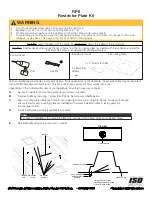
10
regulations. As, depending on the country, different
safety regulations apply when installing and operating
fireplaces You, as the end user of the fireplace system,
the fireplace insert and the stove, are responsible
yourself for compliance with this standard in your region
and for the correct installation of the fireplace.
Camina is not liable for improper installation or
operation. Adhere to the country-specific, regional and
local regulations, e.g. on:
•
Fire protection: A 10 cm thick prewall is required
for components to be protected with a thermal
resistance > 1.2 m² K/W
•
Safety distances
•
Insulating materials
•
Construction law
•
Size of spark protection plates/floor panels
•
Flue tube and chimney connections.
Should you have questions on this, please contact
your specialist dealer or the respective government
authorities.
6.3 Installation
The parts of the system should be fixed with acrylic
adhesive. To obtain optimum strength, the bonding
surfaces must be cleaned and slightly moistened.
Acrylic adhesive residues from parts pressed together
are removed with a spatula. Any irregularities and
shrinkage cracks in the concrete elements can be filled
with repair compound and sanded over. For this purpose,
mix the adhesive provided with water until it obtains
the „consistency of toothpaste“. To avoid small cracks
between the wall and the surround elements, we
recommend using white acrylic compound (Advantage
of acrylic: In contrast to silicone, it can be painted over
immediately). For possible dismantling of the system
later (e.g. due to a relocation), the system components
should only be bonded at certain points with acrylic.
NOTE:
Due to heat expansion, the fireplace surround
must not be positioned directly at the fireplace insert. A
circumferential distance of 2–3 mm from the fireplace
insert door must be complied with. Failure to comply
with this condition will result in damage to the concrete
elements; this damage will not be covered by the gua-
rantee.
Also use the acrylic adhesive to fill in the joints or for
grouting following installation of the fireplace. Filling in
the joints or grouting is an important part of the instal-
lation and makes a major contribution to the stability of
the fireplace.
6.4 Surface design
NOTE: To relax the material tensions, the fireplace
must be heated up once before surface finishing! This
will reduce or prevent cracks in the surface.
Do not mask off the surface! Painter‘s masking tape,
adhesive tape, etc. can leave behind adhesive residues
or even pull off part of the surface.
Coating:
Allow the system to dry for approx. 24 hours.
It can then be coated with an indoor silicate paint
(e.g. Brillux). We recommend priming the system
beforehand. Specialized paint dealers or professional
painters can advise you locally. Filled surfaces are lightly
sanded beforehand with a suitable abrasive. To obtain
a clean, even, fine-grained surface, we recommend
mixing some of the repair compound into the paint. If
necessary, then paint over the system again only with
paint.
Plastering:
Due to the high thermal load, surface cracks
can occur on the individual fireplace components. If no
visible joints or fine cracks are desired, the system can
be plastered.
For this purpose, the system must be provided with a
fabric (glass fibre grid) before plastering.
Use suitable materials from specialized stores.











































